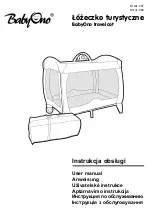
Specifications are subject to alteration without notice.
4 www.swegon.se
1.2
operating Principle
1.2.1 Size 14 and 18 Coolers
BT2 RP2:2 RP2:1
M2
SV EK
BT1 RP1:2 RP1:1
EV2
EV1
VVX2
VVX1
BT3
G1
E1
BT4
M1
Cooling coil
HT
SS
Condenser
coil
Fig. 3
BT1
Hot gas thermostat R134A
BT
Hot gas thermostat R407C
BT3
Brine temperature sensor
BT4
Extract air temperature sensor
RP1:
High pressure switch R134A
RP:
High pressure switch R407C
RP1:1
Low pressure switch R134A
RP:1
Low pressure switch R407C
G1
Brine pump
M1
Compressor R134A
M
Compressor R407C
VVX1
Evaporator
VVX
Evaporator
SV
Safety valve
EK
Expansion vessel
E1
Electrical cubicle with safety switch, power sec-
tion, control card
SS
Start and control signals
EV1
Expansion valve 1
EV
Expansion valve
HT
Hand terminal
operation
There are two refrigerant circuits in the cooling unit The
circuits are separate from one another and each contains a
different type of refrigerant.
Each circuit is equipped with its own heat exchanger on
the cold side. On the warm side, both circuits are arranged
through a condenser coil.
The brine (water/ethylene glycol) passes the heat exchang-
er of both refrigerant circuits.
The refrigerant in gas form is compressed by each com-
pressor and then passes to the condenser coil, where it is
chilled by the air flowing through the coil, and condenses
to liquid form.
A reduction in pressure occurs in expansion valve EV. From
the expansion valve the refrigerant advances to evapora-
tor VVX where the refrigerant vaporises and absorbs heat
from the adjacent medium, i.e. the brine. This chills the
brine. Gas leaves the evaporator and flows back to the
compressor.
Water pump G1 pumps the brine (water/ethylene glycol)
in a circuit from evaporators VVX1 and VVX, where it is
chilled by the refrigerant and advances to the cooling coil,
which in turn cools the supply air flowing to the air han-
dling unit. The refrigerants are never in physical contact
with the brine. Heat and cooling energy are transferred
across the heat exchangers in the evaporator and con-
denser.
Control
In a response to an ON/OFF control signal, the controller
switches in pump G1 and compressor M1. The cooling
capacity is controlled by switching in one or two compres-
sors. On increasing cooling load, the controller switches in
compressor M and at the same time switches out com-
pressor M1. If even more cooling is required, compressor
M1 is switched in to operate together with compressor
M.
If the temperature of the outgoing brine becomes too
low, one of the compressors is switched out. When this
condition subsides, it is restarted automatically. Should the
pressure become too low, the low pressure switch will trip.
The equivalent will occur on the warm side. If the tem-
perature of the exhaust air becomes too high, one of the
compressors is switched out. If the pressure still rises, the
high pressure switch will trip.
gB.Cooler.inSt.060501





































